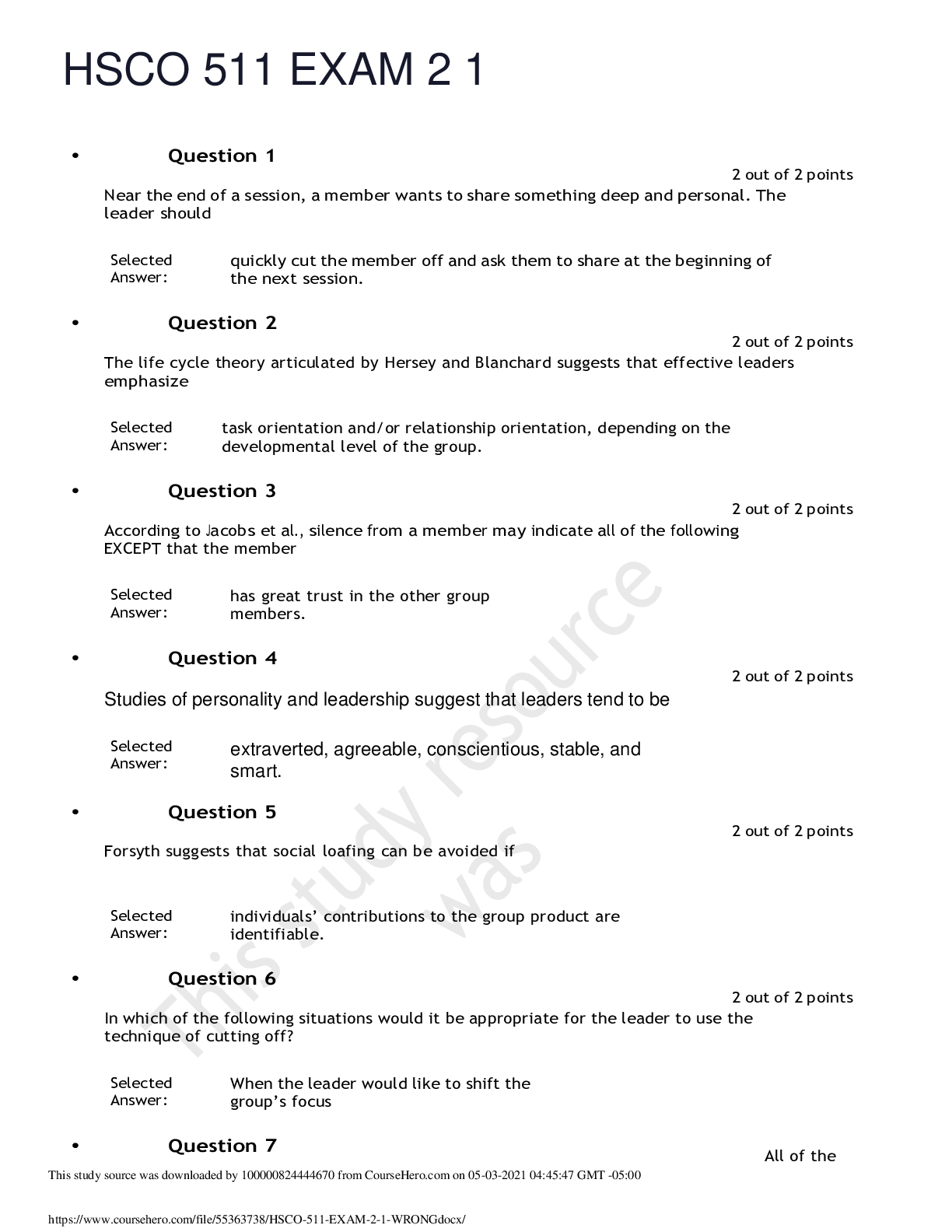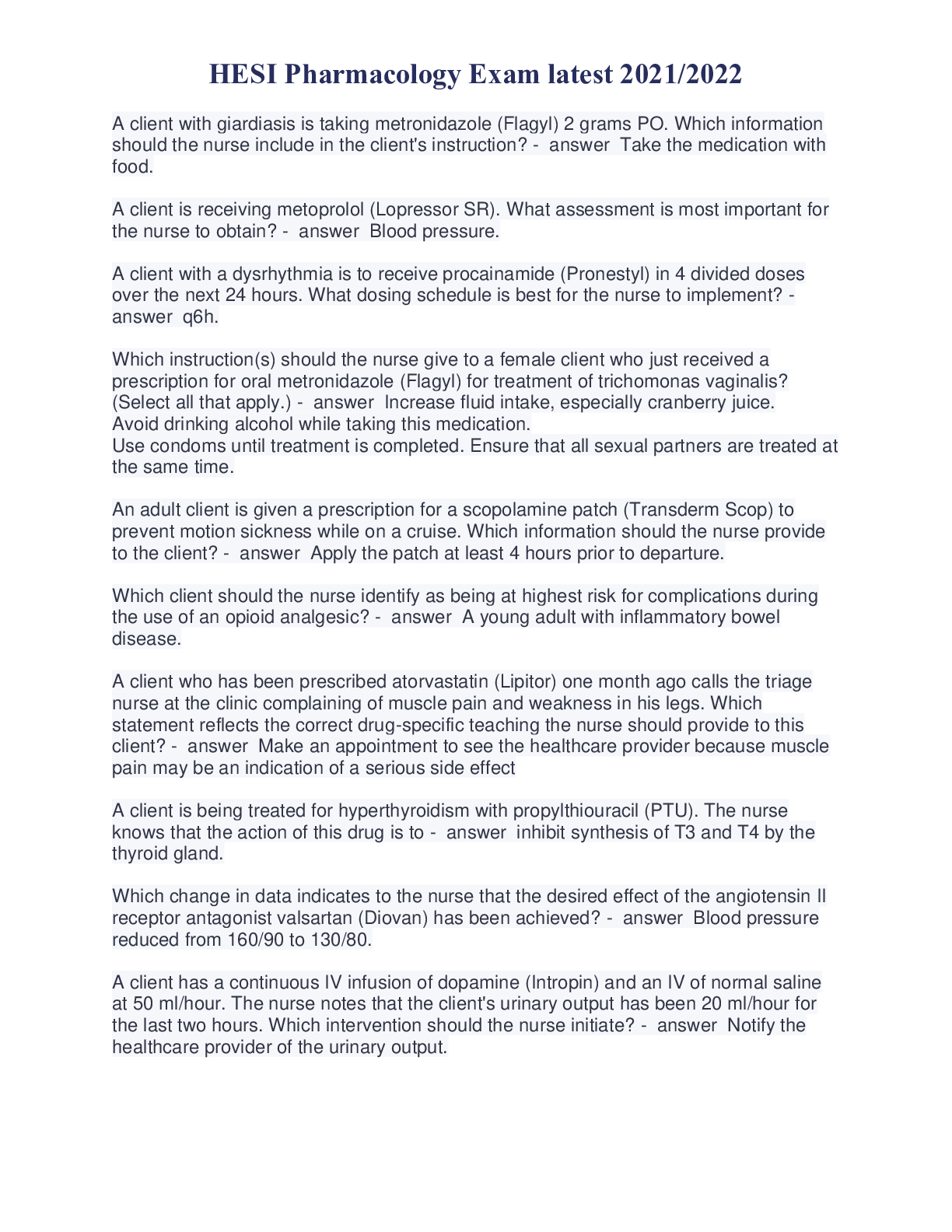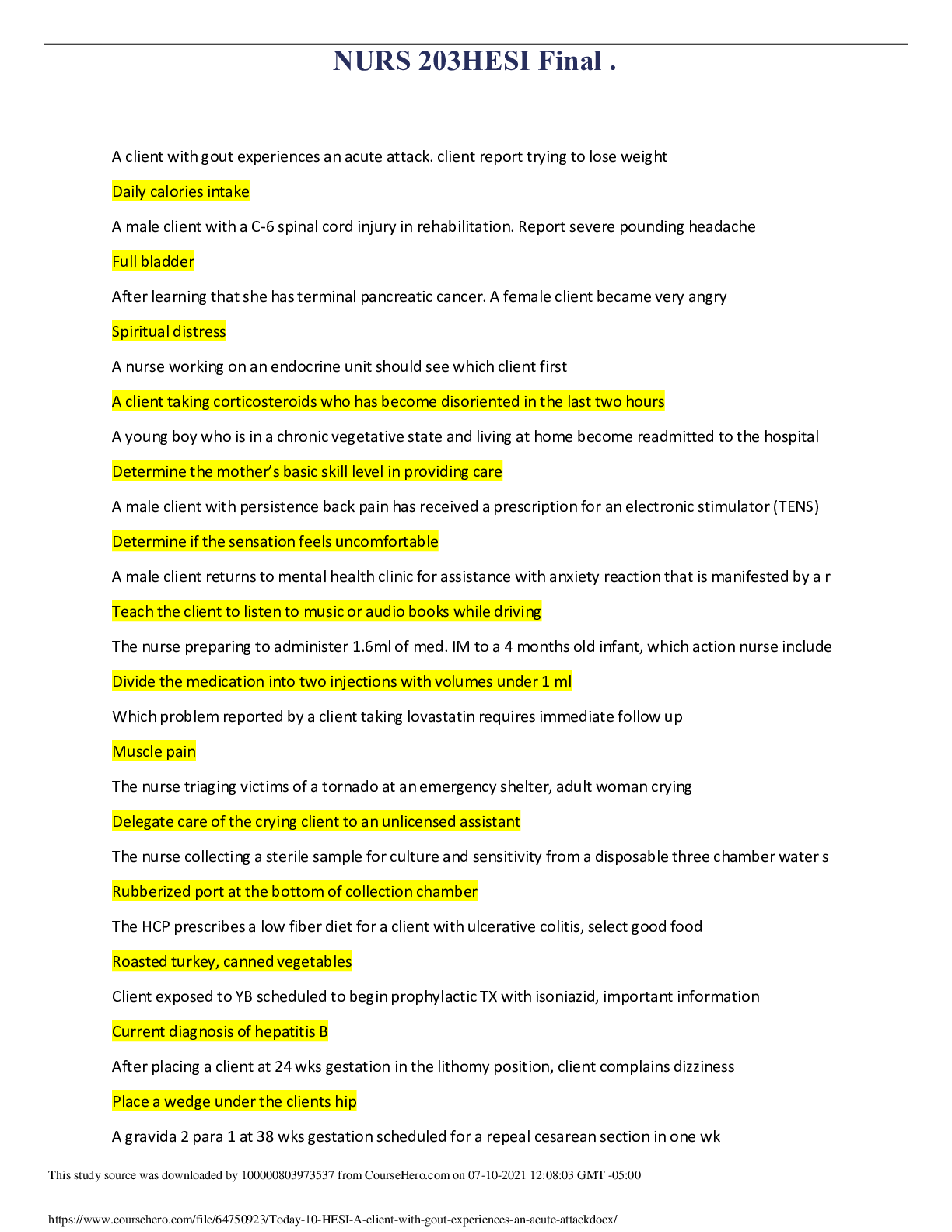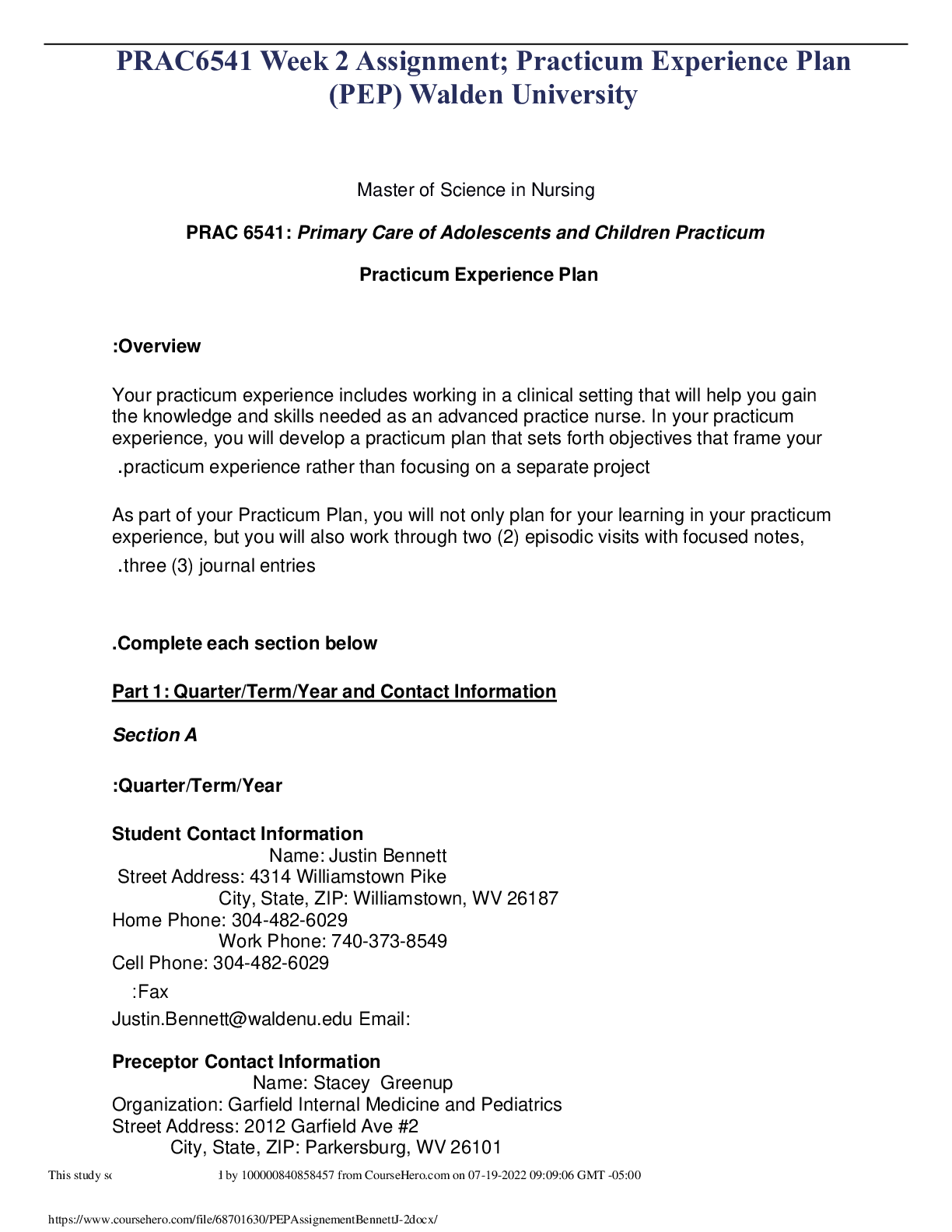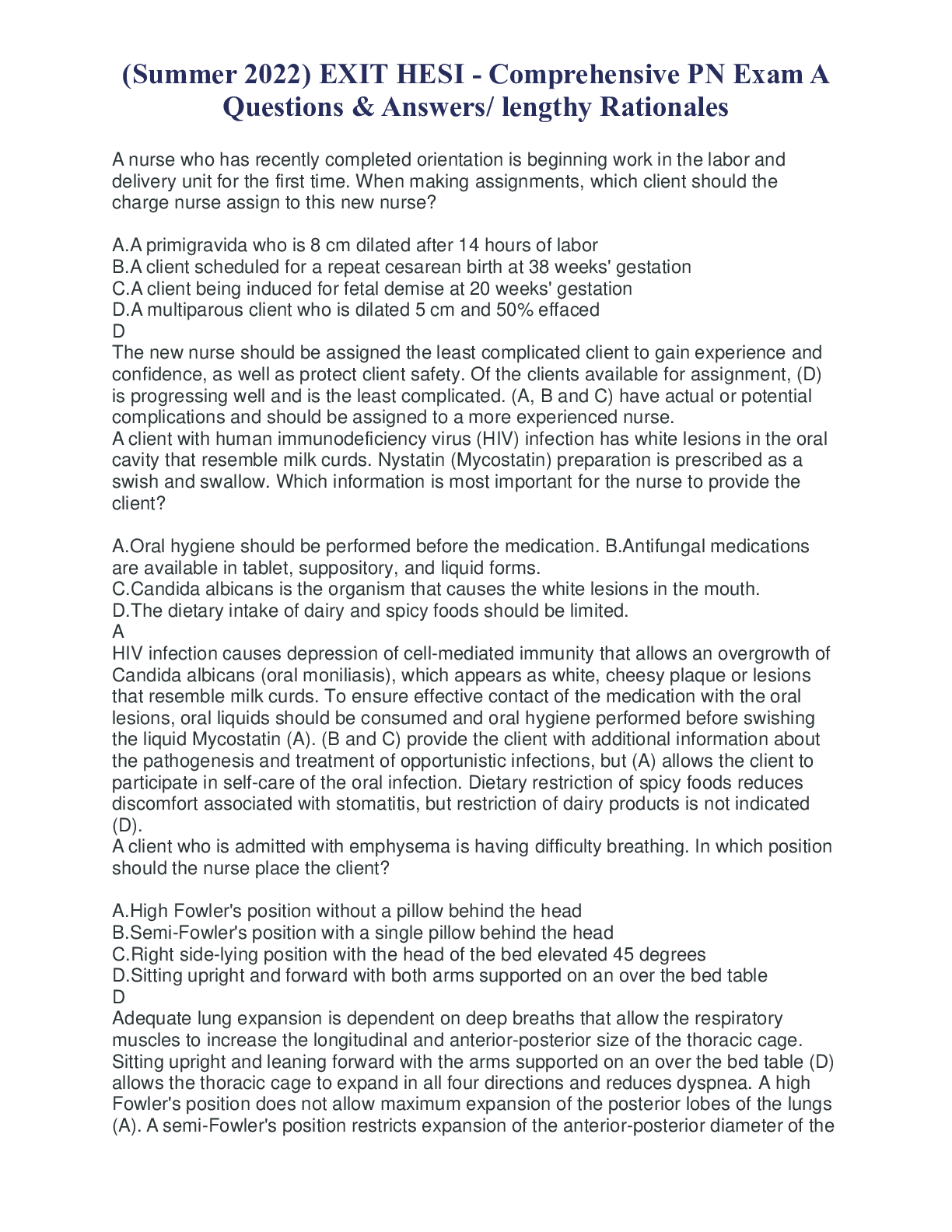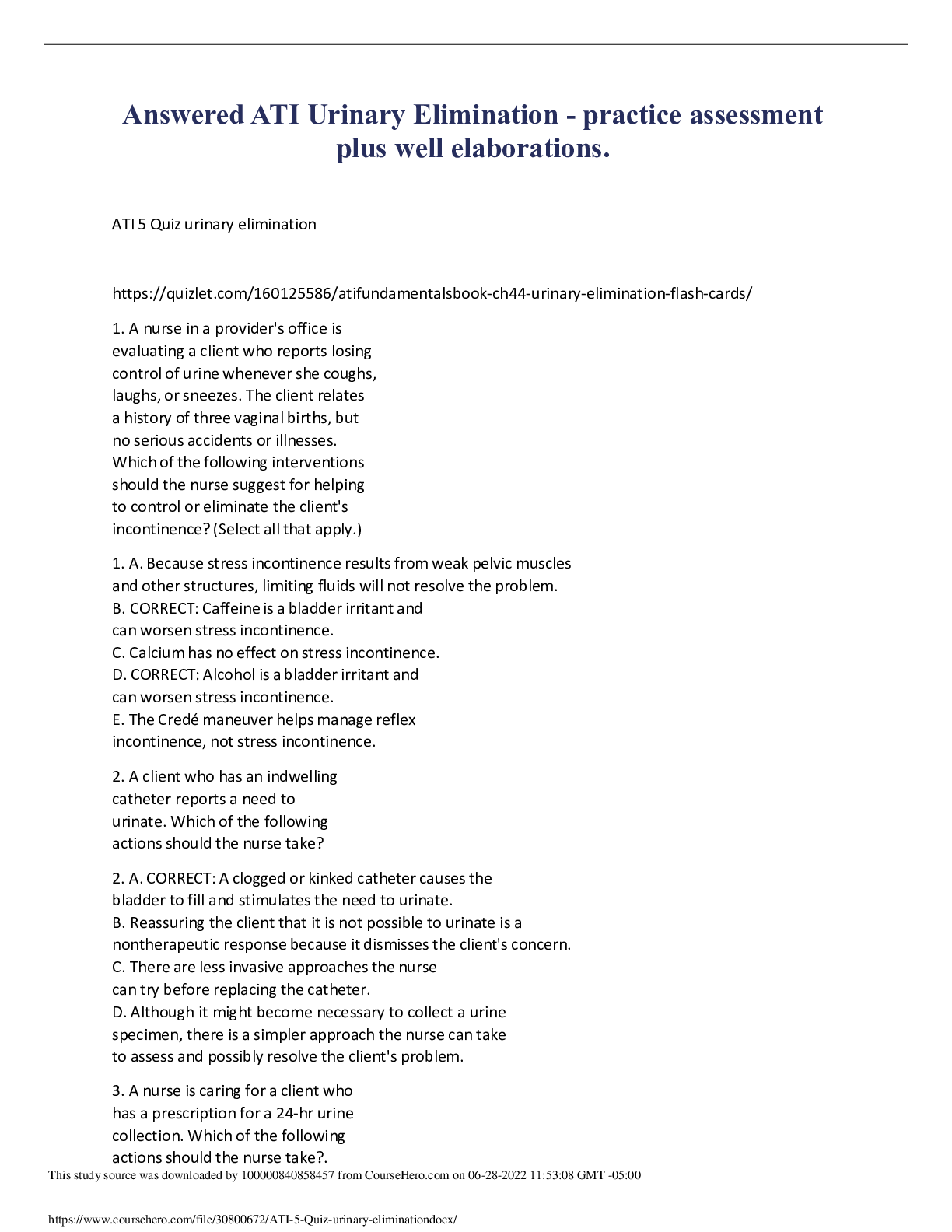*NURSING > EXAM > NURSING 6560, Exam 3 Medsurg | Florida International University | (GRADED A) (All)
NURSING 6560, Exam 3 Medsurg | Florida International University | (GRADED A)
Document Content and Description Below
Chapter 20: 1. Tonsils and adenoids: chain of lymph nodes guarding the body from invasion by organisms entering the nose and the throat. Question from ppt: T or F: The purpose of the cilia is t o move... the mucus back to the pharynx TRUE 2. A prominent function of the sinuses is to serve as a resonating chamber in speech. The sinuses are a common site of infection. 3. Perfusion is influenced by alveolar pressure. The pulmonary capillaries are sandwiched between adjacent alveoli and, if the alveolar pressure is sufficiently high, the capillaries are squeezed. Pulmonary hypertension, in which the capillaries in the alveoli are squeezed excessively Question from ppt: What is gas exchange between the lungs and blood and between the blood and tissues? Respiration 4. Egophony: abnormal change in tone of voice that is heard when auscultating the lungs. Describes voice sounds that are distorted. It is best appreciated by having the patient repeat the letter E. The distortion produced by consolidation transforms the sound into a clearly heard A rather than E 5. Assessment: Abnormal (adventitious) breath sounds: Crackles Wheezes Friction rub 6. Assessment findings consistent with a pleural effusion include affected lung fields being dull to percussion, absence of breath sounds and a pleural friction rub may also be present Pneumonia- egophony, which can be best assessed by instructing the client to repeat the letter E. The distortion produced by consolidation transforms the sound into a clearly heard A rather than E Emphysema-breath sounds are faint or often completely inaudible and the expiratory phase is prolonged 7. Tidal volume (TV)-volume of air inspired and expired with a normal breath 8. Health History: Dyspnea-(subjective feeling of difficult or labored breathing, breathlessness, shortness of breath), how severe is the shortness of breath? On a scale of 1 to 10, if 1 is not at all breathless and 10 is very breathless, how hard is it to breathe? 9. Diagnostic Tests Pulmonary function tests refer to Table 20-9-routinely used in patients with chronic respiratory disorders to aid diagnosis. They are performed to assess respiratory function and to determine the extent of dysfunction, response to therapy and screening. PFT measures how much air moves in and out of your lungs when you breathe Sputum tests-sputum samples ideally are obtained early in the morning before the patient has had anything to eat or drink Chapter 21: 1. Oxygen Toxicity Prevention PEEP or CPAP prevent or reverse atelectasis and allow lower oxygen percentages to be used Question from ppt: The primary oxygen administration method for a patient with COPD is nasal cannula T or F? False – Venturi mask Is the following statement true or false? The patient should be encouraged to use an incentive spirometer approximately 10 breaths per hour between treatments while awake: TRUE 2. Mini-Nebulizer therapy nursing care refer to chart 21-4 Diaphragmatic breathing (see Chart 21-4) is a helpful technique to prepare for proper use of the small-volume nebulizer 3. Endotracheal intubation: Endotracheal and tracheostomy tubes have several disadvantages. The tubes cause discomfort. The cough reflex is depressed because glottis closure is hindered. 4. Tracheostomy: When a tracheostomy or endotracheal tube is in place, it is usually necessary to suction the patient’s secretions because of the decreased effectiveness of the cough mechanism 5. Tracheostomy: Permits the long-term use of mechanical ventilation 6. Maintain patency by proper suctioning-tracheal suctioning is performed when adventitious breath sounds are detected or whenever secretions are obviously present 7. Criteria for weaning-stable vital signs and arterial blood gases are also important predictors of successful weaning. 8. Chest drainage-fluctuation of the water level in the water seal shows effective connection between the pleural cavity and the drainage chamber and indicates that the drainage system remains patent. 9. Improving airway clearance-if the client is retaining secretions, the nurse should first encourage the client to cough before performing more invasive interventions 10. Patient teaching and home care considerations: In addition, respiratory care and other treatment modalities (oxygen; incentive spirometry; CPT; and oral, inhaled, or IV medications) may be continued at home. Therefore, the nurse needs to instruct the patient and family in their correct and safe use Chapter 22: 1. Rhinitis and rhinosinusitis: acute, chronic a. The nurse also educates the patient about the side effects of prescribed and OTC nasal sprays and about rebound congestion (rhinitis medicamentosa) Question on ppt: Acute pharyngitis of a bacterial nature is most commonly caused by group A beta-hemolytic streptococci TRUE What should the nurse palpate when assessing for an upper respiratory tract infection? Neck Lymph Nodes 2. Prevention of upper airway infections-clients with nasotracheal and nasogastric tubes in place are at risk for development of sinus infections Question on ppt: An early sign of cancer of the larynx includes changes in speech, the voice may sound harsh, raspy, and lower in pitch TRUE Chapter 23: 1. The effectiveness of the client's oxygen therapy is assessed by the ABG analysis or pulse oximetry 2. Strategies to expand lungs and manage secretions-include frequent turning, early ambulation, lung-volume expansion maneuvers (deep-breathing exercises, incentive spirometry), and coughing, serve as the first-line measures to minimize or treat atelectasis by improving ventilation a. Incentive spirometer 3. Advocating adherence to the treatment regimen is key in treating the disease and controlling the spread of infection 4. Gerontologic Considerations-the diagnosis of pneumonia may be missed because the classic symptoms of cough, chest pain, sputum production, and fever may be absent or masked in older adult patients. In addition, the presence of some signs may be misleading 5. Key characteristic of pleuritic pain is its relationship to respiratory movement, taking a deep breath, coughing, or sneezing worsens the pain 6. Pleurisy Treat underlying cause, provide analgesia, teaching to splint the rib cage when coughing (The nurse also educates the patient to use the hands or a pillow to splint the rib cage while coughing) 7. Exercises to avoid venous stasis early ambulation, anti-embolism stockings Question on ppt: T or F Bradypnea is the most common sign for a possible pulmonary embolism. FALSE An initial characteristic symptom of a simple pneumothorax is sudden onset of chest pain T or F? TRUE Chapter 24: Question from ppt: For patients with chronic bronchitis the nurse expects to see the major clinical symptoms of tachypnea and tachycardia T or F? FALSE It is sputum and productie cough What is the primary clinical symptom of emphysema? Wheezing 1. Medical Management Reducing risk factors-Chart 24-1-Environmental risk factors for COPD include prolonged and intense exposure to occupational dusts and chemicals, indoor air pollution, and outdoor air pollution 2. Achieving airway clearance-changes in the airway require that the nurse monitor the patient for dyspnea and hypoxemia 3. Bronchiectasis: Nursing Management Patient teaching Postural drainage-Patients and families are taught to perform postural drainage and to avoid exposure to people with upper respiratory or other infections 4. Patient teaching How to identify and avoid triggers-Educating clients about recognizing and avoiding asthma triggers How to perform peak flow monitoring-Peak flow meters measure the highest airflow during a forced expiration Chapter 25: 1. Three layers of the heart endocardium, myocardium and epicardium Question from ppt: Which of the following is the primary pacemaker for the myocardium? Sinoatrial Node 2. Cardiac cycle each cycle has three major sequential events: diastole, atrial systole, ventricular systole 3. Stroke volume (SV) : amount of blood ejected with each heartbeat. 4. Laboratory tests Homocysteine 5. Cardiac Stress Testing exercise stress test terminated when target heart rate is achieved If chest pain develops before HR achieved then stop exam and monitor patient 6. Hemodynamic monitoring central venous pressure Minimally invasive cardiac output monitoring devices - Check transducer, flush system and pressure bag Case study: Mr. Davis has Coronary heart disease (CAD) and is being monitored by a central venous pressure monitoring system. Prior to his admission at the hospital , Mr. Davis was wearing a Holter monitor to check his heart rate and rhythm during his daily routine. Answer the following questions related to this scenario. 1. The nurse was told by the physician that while Mr. Davis was wearing his Holter monitor at home his heart was elevated when performing physical activities. Given his condition, what may an increase in heart rate be an indication of? Myocardial infarction – Elevated heart rate with physical exertion is a potential risk of MI with CAD patients. 2. The nurse notices that the CVP pressure is rising on Mr.Davis. what indication my this be? Hypervolemia – increased CVP pressure is an indication of increased volume, thus a risk of hypervolemia 3. Mr. Davis is ordered orthostatic blood pressures and his blood pressure when Lying, Sitting, and Standing respectively are 150/84, 120/70, and 94/52. What nursing diagnosis should be included in his plan of care? Risk of Falls related to orthostatic hypotension – the patient’s blood pressure decreases when standing and thus must be monitored when leaving the bed or chair. Chapter 26: 1. ECG T wave Question from ppt : The nurse is preparing a male patient to have a 12-lead ECG performed. When prepping the skin the nurse notices that the patient has abundant chest hair. What is the most appropriate nursing intervention to improve adhesion of the ECG leads? A. Use alcohol swabs to clean the skin before applying the leads B. Clip the chest hair with the patient’s permission before applying the leads C. Apply the leads to the arms and legs only D. Reschedule the ECG 2. Nursing process: Care of the patient with a dysrhythmia – planning Goals Eradicating or decreased occurrence of dysrhythmia to maintain cardiac output Question from ppt: The nurse is assessing a patient admitted with a heart block. When placed on a monitor, the patient’s electrical rhythm displays as progressively longer PR durations until there is a nonconducted P wave. Which type of heart block does the nurse expect that this patient has? A. First degree B. Second degree, type I C. Second degree, type II D. Third degree 3. Cardioversion and Defibrillation treat tachydysrhythmias by delivering electrical current that depolarizes (Electrically Stimulates) critical mass of myocardial cells 4. Implantable cardioverter defibrillator Device that detects and terminates life- threatening episodes of tachycardia and fibrillation most common complication is oversensing of dysrhythmia Case study: Mrs. Smith is being followed up by her cardiologist outpatient due to complaints of palpitations while at her new job. The nurse working in the cardiologist office asses the patient prior to seeing her physician. Answer the following questions related to the scenario. 1. The nurse prepares for a routine ECG on Mrs. Smith. What should the nurse do prior to electrode placement? Gently abrade the skin by rubbing the electrode site with dry gauze or cloth. – To assist in enhancing signal transmission. 2. While reading the ECG results, the nurse notices an increased heart rate. What is the patient experiencing? Positive Chronotropy – This phenomena is an Increased Heart Rate , it does not influence dysrhythmias 3. The result of Mrs. Smith ECG is a dysrhythmia; the nurse explains a procedure that involves using a cooled probe to eliminate the source of the dysthymia. What is the nurse explaining to the patient? Cryoablation Therapy – involves using a cooled probe to create a small scar on the endocardium to eliminate the source of the dysrhythmia Chapter 27: Question from ppt: The nurse is caring for a patient with hypercholesterolemia who has been prescribed atorvastatin (Lipitor). What serum levels should be monitored in this patient? A. Complete blood count (CBC) B. Blood cultures C. Na and K levels D. Liver enzymes 1. Angina Pectoris Angina is usually caused by atherosclerotic disease Question from ppt: The nurse is caring for a patient who has severe chest pain after working outside on a hot day and is brought to the emergency center. The nurse administers nitroglycerin to help alleviate chest pain. What side effect should concern the nurse the most? A. Dry mucous membranes B. Heart rate of 88 bpm C. Blood pressure of 86/58 mm Hg D. Complaints of headache 2. Nursing Process: The care of the patient with angina pectoris – Diagnosis Risk for decreased cardiac tissue perfusion 3. Acute coronary syndrome (ACS) and myocardial infarction (MI) Characterized by an acute onset of myocardial ischemia that results in myocardial death (i.e., MI) if definitive interventions do not occur promptly. 4. Nursing process: The care of the patient with ACS – Diagnosis: Risk for decreased cardiac tissue perfusion related to reduced coronary blood flow 5. Nursing Process: The care of the patient with ACS – Nursing interventions: Reduce anxiety-The nurse gives the patient and family time and opportunity to express their fears 6. Nursing Management: ACS/MI Oxygen and medication therapy-supplemental oxygen, aspirin, nitroglycerin, and morphine 7. Percutaneous Coronary Intervention Complications after the procedure may include abrupt closure of the coronary artery and a variety of vascular complications, such as bleeding at the insertion site, retroperitoneal bleeding, hematoma, and arterial occlusion 8. Nursing Management: Patient requiring invasive cardiac intervention Maintain adequate tissue perfusion-Discourage crossing of legs Question from ppt: The nurse is caring for a patient after cardiac surgery. Which nursing intervention is appropriate to help prevent complications arising from venous stasis? A. Encourage crossing of legs B. Use pillows in the popliteal space to elevate the knees in the bed C. Discourage exercising D. Apply sequential pneumatic compression devices as prescribed Chapter 28: 1. Specific valvular disorders mitral valve prolapse Clinical Manifestations: A few have fatigue, shortness of breath, lightheadedness, dizziness, syncope, palpitations, chest pain, or anxiety Mitral valve stenosis Clinical Manifestations: fatigue, hempotysis, dyspnea, pulmonary venous hypertension Question from ppt: The nurse is providing education for a client diagnosed with mitral valve prolapse (MVP). What should be included in the teaching plan? (Select all that apply.) A. MVP is not hereditary B. Caffeine is tolerated in small amounts C. Avoid alcohol D. Stop use of tobacco products E. Prophylactic antibiotics are not prescribed before dental procedures 2. Closed commissurotomy/ balloon valvuloplasty Possible complications include aortic regurgitation, emboli, ventricular perforation, rupture of the aortic valve annulus, ventricular dysrhythmia, mitral valve damage, and bleeding from the catheter insertion sites 3. Balloon valvuloplasty Some Valvuloplasty procedures do not require general anesthesia or cardiopulmonary bypass and can be performed in a cardiac catheterization laboratory or hybrid room 4. Nursing management – Valvuloplasty and Valve Replacement Patient education After undergoing percutaneous balloon valvuloplasty, the patient usually remains in the hospital for 24 to 48 hours Question from ppt: what is the main electrolyte involved in cardiomyopathy? Sodium 5. improve cardiac output and peripheral blood flow Rest, positioning (legs down), supplemental O2, medications, low Na diet, avoid dehydration (patients with HCM avoid diuretics) 6. Prevention ongoing oral hygiene Question from ppt: A patient with restrictive cardiomyopathy taking digoxin presents with symptoms of anorexia, nausea, vomiting, headache, and malaise. What should the nurse expect to be included in the plan of care for this patient? A. The patient’s digoxin will be changed to nifedipine B. The patient’s digoxin dose will be decreased C. Nothing; these are signs of restrictive cardiomyopathy that are expected D. The patient will be admitted to an ICU Chapter 29: 1. Left sided heart failure Clinical Manifestations Low O2 sat-affects oxygen transportation to the brain 2. Medications Hydralazine and isosorbide dinitrate: alternative to ACE inhibitors 3. Medications Beta-blockers: prescribed in addition to ACE inhibitors; may be several weeks before effects seen; use with caution in patients with asthma Question from ppt: Which classification of medications play a pivotal role in the management of HF caused by systolic dysfunction? ACE Inhibitors 4. Activity intolerance Positioning; elevation of the head of bed (High Fowler position) to facilitate breathing and rest, support of arms Question from ppt: What evaluation most illustrates that the patient with HF has met outcomes for the nursing diagnosis “Activity intolerance related to decreased CO?” Maintains heart rate, blood pressure, respiratory rate, and pulse oximetry within the targeted range. 5. Pulmonary Edema As LV begins to fail, blood backs up into the pulmonary circulation, causing pulmonary interstitial edema Question from ppt: What is the most reliable sign of cardiac arrest in an adult and child? Absence of carotid pulse Chapter 30: It was in Blue not sure if its relevant: Continuous-wave Doppler ultrasound detects blood flow, combined with computation of ankle or arm pressures; this combined with computation of ankle or arm pressures; this diagnostic technique helps characterize the nature of diagnostic technique helps characterize the nature of peripheral vascular disease Question from ppt: The nurse is teaching a patient diagnosed with peripheral arterial disease (PAD). What should be included in the teaching plan? Keep the lower extremities in a neutral or dependent position. 1. Venous thromboembolism manifestations If signs and symptoms of VTE are present inform a healthcare provider immediately. Question from ppt: Which patient is at highest risk for venous thromboembolism? A 25 year old patient with a central venous catheter in place to treat septicemia Rationale: Some risk factors for venous thromboembolism include but are not limited to age older than 65 years, patients undergoing surgery, central venous catheter placement, septicemia, and pregnancy. The client in this question with two risk factors is the 25 year old with a central venous catheter in place to treat septicemia. All other patients only have one risk factor 2. Promoting adequate nutrition High protein, high calorie intake 3. Lymphangitis: inflammation or infection of the lymphatic channels-characteristic red streaks that extend up the arm or the leg from an infected wound outline the course of the lymphatic vessels as they drain Chapter 31: 1. Prehypertension: systolic BP 120-129 or Diastolic Bp 80-89 2. Incidence of hypertension Secondary hypertension – Has a specific cause 3. Incidence of hypertension Highest prevalence in African Americans 4. Major risk factors Dyslipidemia -Elevated lipid levels 5. Major risk factors older age, family history Question from ppt: For patients with uncomplicated hypertension and no specific indications for another medication, what is the initial medication? Thiazide diuretic 6. Evaluation and outcomes Adheres to the self -care program Takes medications as prescribed and report side effects. , Measures BP routinely Question from ppt: The nurse is preparing an education plan for a patient newly diagnosed with hypertension. What should be included in the education plan? Engage in regular aerobic physical activity such as brisk walking (at least 30 min/day most days of the week) Case study: Mr. David has been diagnosed with hypertension. His current BP’s have been 140/91, 144/93, 150/90. Mr. David attends a community health expo where a nurse is providing education on hypertension. 1. Mr. David ask the nurse what happens if his systolic BP is consistently in the 160’s and not being controlled properly? Kidney Injury – Uncontrolled HTN can cause kidney injury 2. Mr. David is prescribed Microzide for his hypertension. Mr. David ask what does this medication do. Nurse responds with . Helps to increase urine output. – Microzide, or Hydrochlorothiazide, is a thiazide diuretic that helps to reduce hypertension by increasing urine output. Educate the patient to take early in the day as oppose to bedtime due to its effect of causing frequent urination. Show Less [Show More]
Last updated: 2 years ago
Preview 1 out of 11 pages

Buy this document to get the full access instantly
Instant Download Access after purchase
Buy NowInstant download
We Accept:

Reviews( 0 )
$17.00
Can't find what you want? Try our AI powered Search
Document information
Connected school, study & course
About the document
Uploaded On
Sep 02, 2021
Number of pages
11
Written in
Additional information
This document has been written for:
Uploaded
Sep 02, 2021
Downloads
0
Views
98


